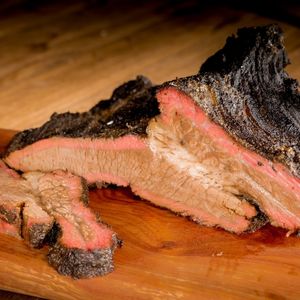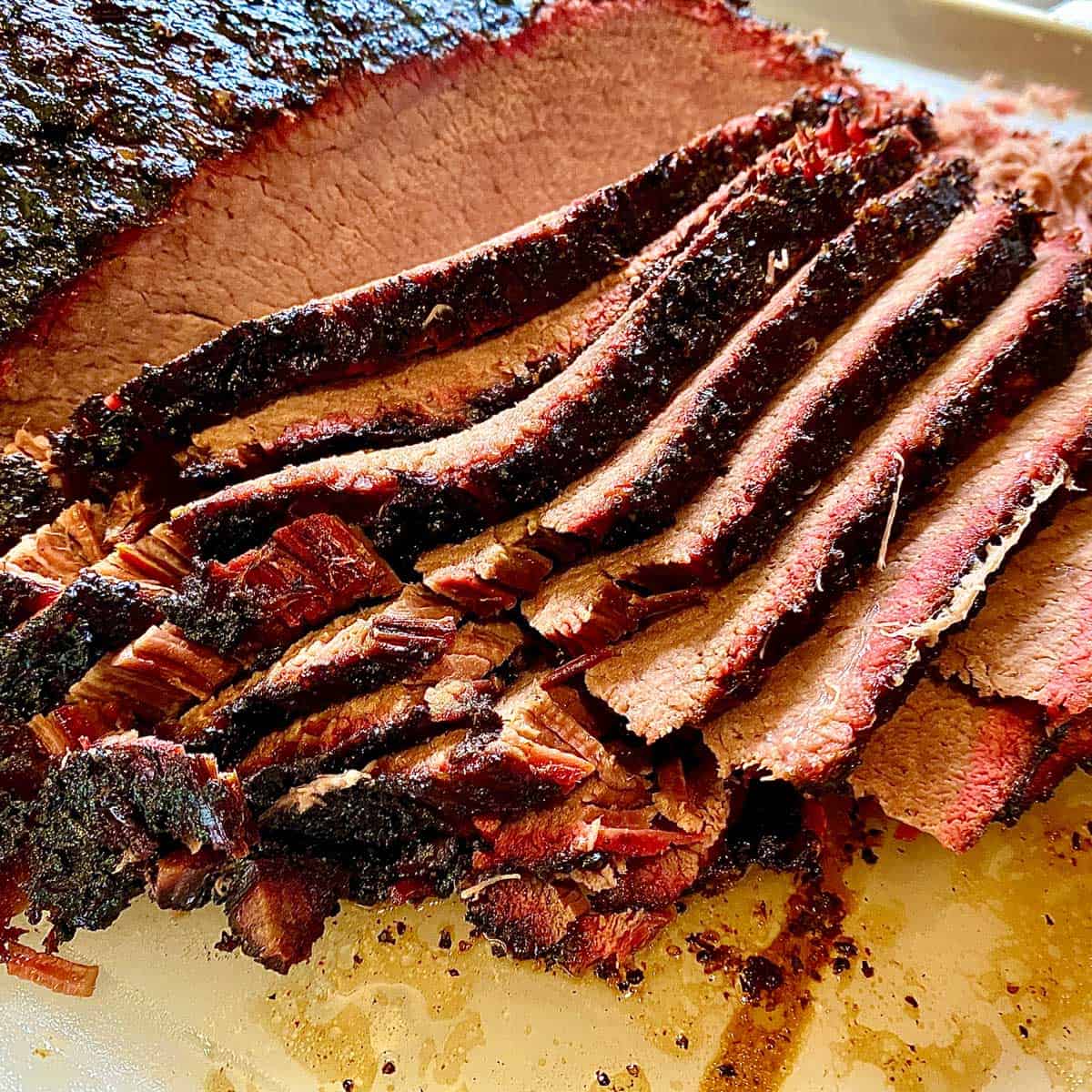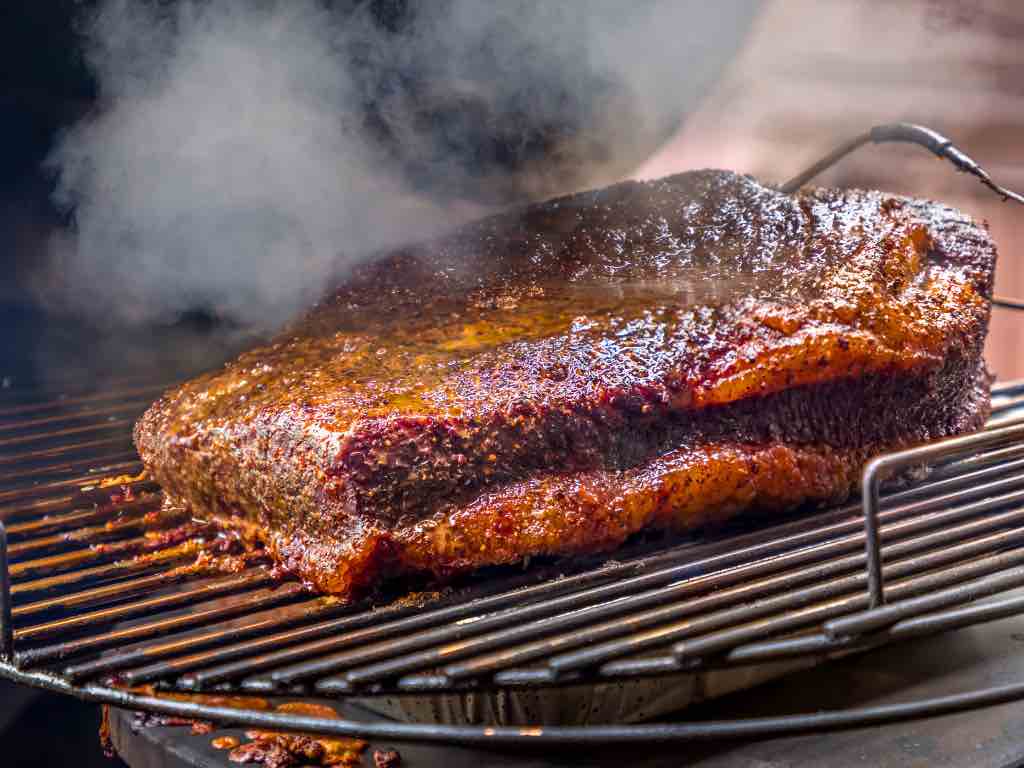
Introduction
In the world of barbecuing and smoking meat, one of the key elements to producing a delicious and tender brisket is the resting period. Resting brisket after cooking is crucial for achieving the perfect texture and flavor. While it may be tempting to dig into the juicy meat immediately after it comes off the smoker, taking the time to let it rest can make all the difference.
Why Resting Brisket Is Important
Resting a brisket allows the meat to reabsorb some of its juices, resulting in a more flavorful and moist final product. It gives the collagen in the meat time to break down further, making it more tender and easier to slice. Additionally, resting allows the temperature inside the meat to equalize, ensuring that it doesn’t continue to cook and become overdone.
Another benefit of resting brisket is that it allows the crust or bark on the outside of the meat to firm up. This crust is formed during the initial searing and smoking process and can become softer if the brisket is immediately sliced. By giving it time to rest, the bark will retain its texture, providing a satisfying crunch with each bite.
The Science Behind Resting Brisket For Perfect Meat
The science behind resting brisket lies in the phenomenon known as carryover cooking. When meat is subjected to heat, the heat causes the proteins to contract and expel moisture. However, as the meat rests, the proteins relax and reabsorb some of the expelled moisture, resulting in a juicier end product.
During the resting period, the temperature inside the brisket also starts to equalize. The exterior of the meat is much hotter than the interior when it first comes off the smoker. By letting it rest, the residual heat distributes evenly throughout the brisket, leading to a more uniform and consistent doneness.
Overall, resting brisket is an essential step in the barbecuing process that should not be overlooked. By allowing the meat to rest, you are ensuring that it retains its juiciness, tenderness, and flavor. So next time you fire up the smoker, be patient and let your brisket rest before diving in for a truly delicious experience.
The Resting Process
Exploring The Different Stages Of Resting Brisket
After the brisket has finished cooking, it needs to go through several stages of resting in order to achieve the best results. The first stage is known as the immediate rest, where the meat is removed from the smoker and placed on a cutting board or in a roasting pan. This stage typically lasts for about 15 to 30 minutes, allowing the brisket to cool down slightly and the juices to settle.
Once the immediate rest is complete, the brisket enters the second stage of resting, which is commonly referred to as the wrapped rest. At this stage, the brisket is tightly wrapped in foil or butcher paper to help retain its heat and moisture. This allows the brisket to continue cooking in its own juices, resulting in a more tender and flavorful final product. The wrapped rest usually lasts for an additional 1 to 2 hours.
After the wrapped rest, the brisket transitions into the final stage of resting, which is known as the extended rest. During this stage, the wrapped brisket is placed in a cooler or insulated container to keep it warm for an extended period of time. This rest allows the meat to fully reabsorb its juices and for the flavors to further develop. The extended rest can last anywhere from 2 to 4 hours, depending on personal preference and the specific needs of the meat.
How Long To Let Brisket Rest For Optimal Results
The ideal duration for brisket resting depends on various factors, including the size of the brisket, cooking temperature, and desired level of tenderness. As a general rule of thumb, it is recommended to let the brisket rest for at least 30 minutes to 1 hour after it has finished cooking.
For smaller briskets or those cooked at higher temperatures, a shorter resting period may be sufficient. On the other hand, larger briskets or those cooked at lower temperatures might benefit from a longer resting period of 1 to 2 hours or more.
Ultimately, the goal is to allow the brisket to cool down slightly, reabsorb its juices, and for the internal temperature to equalize. This will result in a moist, tender, and flavorful brisket that is ready to be sliced and enjoyed.
In conclusion, the resting period is a crucial step in the barbecuing process to achieve the perfect texture and flavor in a brisket. By following the different stages of resting and allowing the brisket to rest for the appropriate duration, you can ensure a juicy, tender, and delicious end result. So, be patient and give your brisket the time it needs to rest before serving it up for a truly satisfying meal.
The Ideal Resting Time
Factors To Consider When Determining How Long To Let Brisket Rest
The ideal resting time for a brisket depends on several factors, including its size, cooking temperature, and desired tenderness. Here are some factors to consider when determining how long to let your brisket rest:
- Size of the brisket: Larger briskets will benefit from a longer resting period to allow the internal temperature to equalize and the flavors to develop fully.
- Cooking temperature: If you cooked your brisket at higher temperatures, it may require a shorter resting period as the carryover cooking will be less compared to lower temperature cooking.
- Desired tenderness: The resting period allows the brisket to become more tender by allowing the connective tissues to relax and the juices to redistribute.
Recommended Resting Times For Different Sizes Of Brisket
While the resting time can vary depending on personal preference, here are some general guidelines for resting times based on the size of the brisket:
- Small briskets (around 4-6 pounds): Rest for approximately 30 minutes to 1 hour.
- Medium-sized briskets (around 6-10 pounds): Rest for 1 to 2 hours.
- Large briskets (10 pounds or more): Rest for 2 to 3 hours or more.
- Remember that these are just recommendations, and the final resting time should be adjusted according to the specific needs of your brisket and your desired level of tenderness.
By allowing your brisket to rest for the appropriate duration, you can ensure that it retains its juices, becomes more tender, and develops a richer flavor. This resting period is an essential step in the cooking process and should not be skipped. So, be patient and give your brisket the time it needs to rest before serving it up for a truly satisfying meal.

Benefits Of Resting Brisket
Enhanced Tenderness And Juiciness
One of the main benefits of letting your brisket rest is that it allows the connective tissues in the meat to relax. This results in a more tender and moist brisket, as the proteins have time to break down and become more tender. Additionally, during the resting period, the juices inside the meat redistribute, ensuring that each bite is juicy and flavorful.
Improved Flavor Development
Resting your brisket also allows the flavors to develop and deepen. As the brisket sits, the different seasonings and spices have time to meld together, creating a more cohesive and balanced taste. The resting period also allows the meat to reabsorb some of the flavorful juices that were released during the cooking process, enhancing the overall flavor profile of the brisket.
By taking the time to properly let your brisket rest, you can enjoy a more tender and flavorful final product. Here are some additional tips to keep in mind when resting your brisket:
- Cover the brisket: To retain heat and moisture, tightly wrap the brisket in foil or butcher paper during the resting period. This will help the meat retain its juices and prevent it from drying out.
- Choose the right resting surface: Place the brisket on a cutting board or a clean, heat-resistant surface during the resting period. Avoid placing it on a cold surface, as this could cause the meat to cool down too quickly and affect its tenderness.
- Adjust resting time based on thickness: If you have a particularly thick brisket, you may need to extend the resting time to ensure that the center of the meat reaches the desired temperature and tenderness.
Remember, these are just guidelines, and the resting time for your brisket may vary based on personal preference and specific cooking factors. The key is to allow the brisket enough time to rest and let the flavors and textures fully develop. So be patient, resist the temptation to cut into the brisket too soon, and you’ll be rewarded with a delicious, melt-in-your-mouth brisket.
Resting Methods And Techniques
Different Ways To Rest Brisket
There are several methods and techniques you can use to rest your brisket after cooking. Here are a few options:
- Foil wrap: One common method is to tightly wrap the brisket in foil during the resting period. This helps retain heat and moisture, keeping the meat tender and juicy.
- Butcher paper wrap: Another popular option is to wrap the brisket in butcher paper. This allows some airflow, preventing the meat from becoming soggy while still retaining moisture.
- Resting in a cooler: Some people prefer to place the wrapped brisket in a cooler to keep it warm and allow it to rest. This method can be especially useful if you need to hold the brisket for a longer period before serving.
Choosing The Right Method For Your Cooking Style
The method you choose to rest your brisket will depend on your cooking style and preferences. Here are some factors to consider:
- Desired tenderness: Foil wrapping tends to result in a very tender brisket, while butcher paper allows for a slightly firmer texture. Consider how tender you want your meat to be and choose the appropriate method.
- Time constraints: If you’re short on time, using a cooler to rest the brisket can help keep it warm for an extended period. However, keep in mind that this method may alter the texture slightly.
- Personal preference: Ultimately, the choice of resting method comes down to personal taste. Some pitmasters swear by foil wrapping, while others prefer butcher paper or resting in a cooler. Experiment with different methods to find the one that suits your taste best.
It’s important to remember that the resting time may vary depending on the size and thickness of the brisket. The general rule of thumb is to allow the brisket to rest for at least 30 minutes to an hour. This gives the meat time to reabsorb the juices and reach its optimal tenderness.
By choosing the right resting method and giving your brisket the time it needs to rest, you’ll be rewarded with a tender, flavorful, and melt-in-your-mouth brisket that will impress your family and friends.
Monitoring The Resting Period
Tips For Maintaining The Ideal Temperature During Resting
During the resting period, it’s important to monitor the temperature of your brisket to ensure it stays at the ideal level. Here are some tips to help you maintain the right temperature:
- Use a meat thermometer: Invest in a quality meat thermometer to accurately gauge the internal temperature of the brisket. This will help you determine when it’s done cooking and when it has reached the desired temperature for resting.
- Keep an eye on the thermometer: Check the temperature of the brisket regularly to ensure it does not drop too low. If the temperature starts to decrease, you may need to make adjustments to keep it warm.
- Avoid opening the wrapping frequently: Every time you open the foil or butcher paper, heat escapes, which can lead to a drop in temperature. Try to avoid constantly checking on the meat and only open it when necessary.
Preventing The Brisket From Drying Out Or Becoming Cold
To prevent your brisket from drying out or becoming too cold during the resting period, consider the following tips:
- Keep it wrapped tightly: Whether you choose to use foil or butcher paper, make sure to wrap the brisket tightly to prevent moisture from escaping. This will help retain the juiciness and tenderness of the meat.
- Use a warm environment: If you’re resting the brisket in a cooler, pre-warm it by placing hot water inside before adding the wrapped meat. This will help maintain the temperature and prevent it from getting too cold.
- Time it right: Plan your cooking and resting times accordingly to ensure that the brisket is ready to be served when needed. Factor in the resting period so that the meat has enough time to fully absorb the juices and reach its optimal tenderness.
By following these tips, you can ensure that your brisket stays at the ideal temperature during the resting period and remains juicy and tender. Be mindful of the temperature and timing, and you’ll be rewarded with a delicious and flavorful brisket that will impress anyone who takes a bite.

Resting Tips For Perfect Meat
Covering Brisket During Resting
During the resting period after cooking your brisket, it is crucial to cover it properly to retain its moisture and tenderness. Here are some tips for covering your brisket:
- Choose the right wrapping: Whether you prefer foil or butcher paper, ensure that the wrapping is tight and secure. This will help prevent moisture from escaping and maintain the juiciness of the meat.
- Consider double wrapping: If you want to provide an extra layer of insulation, you can double wrap your brisket. This can help retain more heat and keep the meat warm during the resting period.
- Seal any gaps: Make sure there are no gaps or openings in the wrapping that could allow heat to escape. Use additional layers of foil or butcher paper if needed, ensuring a tight seal.
Allowing The Juices To Redistribute
During the resting period, it is essential to allow the juices in the brisket to redistribute evenly. This will result in a more tender and flavorful final product. Here are some tips for ensuring proper redistribution of juices:
- Do not rush the resting period: It is recommended to rest the brisket for at least 30 minutes to an hour. This allows the juices to settle and be absorbed back into the meat.
- Elevate the brisket: Place the wrapped brisket on a rack or a cutting board during the resting period. This will prevent it from sitting in its own juices, which can make the bottom soggy.
- Do not puncture the meat: Avoid poking or slicing into the brisket while it is resting. This can cause the juices to escape, resulting in a drier end product.
By following these tips, you can ensure that your brisket remains moist and tender during the resting period. Properly covering the meat and allowing the juices to redistribute will result in a delicious and flavorful final product. Remember to be mindful of the wrapping and resting time, and you will be rewarded with perfectly cooked meat that will impress your guests.
Testing The Rested Brisket
Determining If The Brisket Has Rested Enough
To ensure that your brisket has rested enough, you can perform a simple test. Here’s how you can determine if the brisket has rested adequately:
- Use a meat thermometer: Insert a meat thermometer into the thickest part of the brisket. If the internal temperature reads around 195°F to 205°F, it indicates that the brisket has reached its ideal doneness and has had sufficient resting time.
- Check for tenderness: Gently press your finger against the brisket. If it feels tender and yields slightly to the touch, it suggests that the meat has been adequately rested and will be juicy and flavorful.
Signs Of A Properly Rested Brisket
When a brisket has been appropriately rested, you can expect the following signs:
- Juicy and moist: The meat should be juicy, with the juices evenly distributed throughout the brisket. The resting period allows the juices to redistribute, resulting in a moist and succulent final product.
- Improved tenderness: Resting helps the muscle fibers relax and become more tender. A properly rested brisket will be tender and easy to slice, with a pleasant texture.
- Enhanced flavor: Allowing the brisket to rest allows the flavors to develop and intensify. The resting time allows the seasonings and spices to meld together, resulting in a more flavorful eating experience.
By testing the rested brisket and looking out for these signs, you can ensure that your meat is perfectly cooked and ready to be enjoyed. Remember to let the brisket rest adequately to achieve the desired results.
Testing The Rested Brisket
Determining If The Brisket Has Rested Enough
To ensure that the brisket has rested enough, a simple test can be performed. Here’s how to determine if the brisket has had sufficient resting time:
- Use a meat thermometer: Insert a meat thermometer into the thickest part of the brisket. If the internal temperature reads around 195°F to 205°F, it indicates that the brisket has reached its ideal doneness and has had enough resting time.
- Check for tenderness: Gently press a finger against the brisket. If it feels tender and yields slightly to the touch, it suggests that the meat has been adequately rested and will be juicy and flavorful.
Signs Of A Properly Rested Brisket
When a brisket has been appropriately rested, the following signs can be expected:
- Juicy and moist: The meat should be juicy, with the juices evenly distributed throughout the brisket. The resting period allows the juices to redistribute, resulting in a moist and succulent final product.
- Improved tenderness: Resting helps the muscle fibers relax and become more tender. A properly rested brisket will be tender and easy to slice, with a pleasant texture.
- Enhanced flavor: Allowing the brisket to rest allows the flavors to develop and intensify. The resting time allows the seasonings and spices to meld together, resulting in a more flavorful eating experience.
By testing the rested brisket and looking out for these signs, one can ensure that the meat is perfectly cooked and ready to be enjoyed. Remember to let the brisket rest adequately to achieve the desired results.
Conclusion
The Importance Of Patience In Achieving The Perfect Brisket
Patience is integral to achieving the perfect brisket. While it may be tempting to immediately dig into the meat after it’s done cooking, allowing it to rest is vital. Resting gives the meat time to reabsorb and distribute its juices, resulting in a more flavorful and tender brisket.
Properly resting a brisket also facilitates the relaxation of the muscle fibers, ensuring a tender and easily sliceable final product. Without patience, the brisket may be tough and dry, lacking the desired texture and juiciness.
Final Thoughts And Recommendations
Resting the brisket is not a step that can be skipped or rushed. It is worth the wait for the improved flavor and texture it brings. Remember to plan ahead and allow for an adequate resting time, typically around 30 minutes to an hour, depending on the size of the brisket.
Additionally, after the resting period, it’s important to slice the brisket against the grain for optimal tenderness. This will help prevent chewiness and ensure each bite is melt-in-your-mouth tender.
Overall, taking the time to properly rest your brisket is a crucial step in achieving a mouthwatering and delicious final result. So be patient, trust the process, and savor the rewards of a perfectly rested brisket.
Frequently Asked Questions about How Long to Let Brisket Rest: Patience for Perfect Meat
Q: Why is it important to let brisket rest after cooking?
A: Letting brisket rest allows the juices to redistribute, resulting in a moist and tender final product. Resting also helps the flavors to develop and the meat to retain its juiciness.
Q: How long should I let brisket rest?
A: The general recommendation is to let brisket rest for at least 30 minutes, but up to an hour is even better. The exact resting time depends on the size of the brisket and the cooking method used.
Q: What happens if I don’t let the brisket rest?
A: If you don’t let brisket rest, slicing into it too soon can cause all the flavorful juices to run out, leaving you with a dry and tough piece of meat. Resting allows the meat to retain moisture and tenderness.
Q: Can I let the brisket rest for too long?
A: Yes, letting brisket rest for too long can cause it to cool down significantly, which might affect the taste and texture negatively. However, a resting time of up to one hour is generally safe and recommended.
Q: How should I rest the brisket?
A: To rest the brisket, remove it from the heat source and tent it loosely with aluminum foil. This helps retain some heat without steaming the meat. You can also place it in a clean, warm cooler if you need to rest it for a longer period.
Q: What should I do during the resting time?
A: While the brisket rests, resist the temptation to slice into it right away. Use this time to prepare any accompanying side dishes, carve the meat when it has reached the desired resting time, and enjoy the anticipation of tasting your perfectly cooked brisket.
Q: Can I reheat the brisket after it has rested?
A: Yes, if you find that your brisket has cooled down too much during the resting time, you can gently reheat it before serving. Wrap it in foil and warm it in a low-temperature oven or grill until it reaches the desired serving temperature.
Q: Is resting time the same for all cooking methods?
A: The resting time may vary slightly depending on the cooking method used. For example, brisket cooked using low and slow methods, such as smoking or roasting, often requires a longer resting time compared to grilled brisket.
Q: Can I refrigerate the brisket after it has rested?
A: Yes, if you have leftover brisket after it has rested, you can refrigerate it for later consumption. Allow it to cool completely before storing it in an airtight container in the refrigerator. When you’re ready to enjoy it again, gently reheat it to restore its tenderness and juiciness.
Q: Does resting time affect the flavor of the brisket?
A: Yes, giving the brisket enough resting time allows the flavors to meld together, resulting in a more flavorful and enjoyable eating experience. The patience in letting the meat rest is rewarded with enhanced taste and texture.
Remember, patience is key when it comes to cooking brisket. Taking the time to let it rest after cooking will ensure that you achieve the most tender, juicy, and flavorful results.

We are family-owned and operated. We love to serve coffee to our community that loves to drink it! We opened in December 2017 and are always expanding and evolving. We strive to offer a relaxing and comfortable gathering place for our customers. We not only serve delicious coffee but a full breakfast and lunch menu as well. You can also order ONLINE through our website or call ahead and pick it up right at our drive-thru window! We have a wide range of delicious baked goods, sweet treats, and a gift shop coming soon! Stop in and let us serve you!!